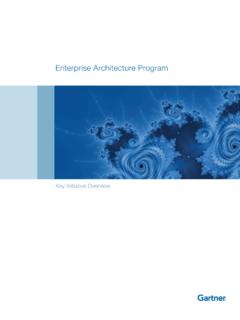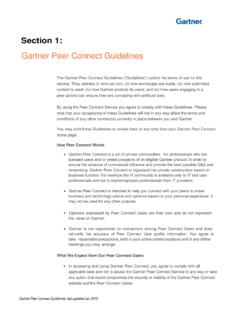Transcription of Cloud Strategy Leadership - gartner.com
1 gartner Insights on How and Why Leaders Must Implement Cloud Computing Cloud Strategy LeadershipEDITED BY David Mitchell Smith, Vice President and gartner Fellow 2017 gartner , Inc. and/or its affiliates. All rights reserved. gartner is a registered trademark of gartner , Inc. or its affiliates. For more information, email or visit Strategy Leadership2 Have you or your CIO expressed any of these concerns?These are just a few of the myths that surround the world of Cloud computing. In truth, Cloud computing has several variations and combinations, ranging from no Cloud to pure Cloud , depending on the organization s C-suite will look to the CIO to answer questions about Cloud computing and to help define a Strategy to successfully integrate Cloud into the day-to-day workings of an enterprise. As Cloud computing makes its way into its second decade, the options and combinations are expanding to fit each company Mitchell Smith Vice President and gartner FellowPure Cloud is the only option.
2 Companies can only use one Cloud Strategy is necessary to start implementing Cloud . With this book, CIOs can familiarize themselves with various types of Cloud options and begin to create a framework to move their enterprise toward leveraging Cloud computing. CIOs will also learn about security in the Cloud and what type of talent is necessary for a successful Cloud is not secure. Cloud Strategy Leadership3 ContentsThe Need for Cloud StrategyCHAPTER 104 Securing the CloudCHAPTER 213 Developing Cloud TalentCHAPTER 316 Assess Cloud OptionsCHAPTER 421 Cloud Strategy Leadership4 The Need for Cloud StrategyCHAPTER 1 Cloud Strategy Leadership5 Earlier this year, the CIO at a large construction materials company realized that by updating its aging IT infrastructure and modernizing the business, the company could expand into other markets and open opportunities for an additional $4 million in annual revenue. Additionally, an updated digitized system would save the company $1 million per year in supply chain costs.
3 But when the CIO took the idea to the CEO, she was concerned about the risks of moving all the systems to a Cloud service, particularly given that the company worked with a few highly sensitive government contracts. Additionally, peer CEOs had shared cautionary tales about trying to move to Cloud , and she was hesitant about the initial investment. The CIO knew the CEO was interested in the potential additional revenue and saved costs, and knew he needed to counter the myths that accompany mentions of the word Cloud . So to gain buy-in from the CEO and board to move forward, he explained that first they would create a Cloud Strategy to focus their Cloud efforts on select business goals. Next, he explained a framework that would move certain parts of the business, such as logistics systems and ordering systems, to the Cloud , while ensuring government contracts remained compliant with regulations. As an added bonus, he explained that Cloud services would enable the company to scale up during the busy summer months, and scale down during the slower winter months.
4 After dispelling myths and providing a plan, the CIO convinced the CEO to begin the a decade of Cloud it may come as a surprise that the issue of Cloud computing is still perplexing to many CIOs. Although Cloud computing is a foundation for digital business, gartner estimates that less than one-third of enterprises have a documented Cloud defines Cloud computing as a style of computing in which scalable and elastic IT-enabled capabilities are delivered as a service using internet Need for Cloud StrategyCloud Strategy Leadership6 A Cloud Strategy clearly defines the business outcomes you seek, and how you are going to get there. Having a Cloud Strategy will enable you to apply its tenets quickly with fewer delays, thus speeding the arrival of your ultimate business outcomes, says Donna Scott, research vice president and distinguished analyst. As part of the Cloud Strategy , CIOs need to educate their CEOs and boards of directors about the need to invest in Cloud as a style of computing that drives greater speed, agility and innovation through this democratization of IT.
5 In doing so, they should use their digital business Strategy to justify the investments needed for Cloud business requires speed and agility that Cloud computing provides through the use of Cloud services that become available to a broader set of users through a self-service interface. Users help themselves to these Cloud services, stimulating creativity and innovation. Organizations that do not have a high-level Cloud Strategy driven by their business Strategy will significantly increase their risk of failure and wasted investment, says David Cearley, vice president and gartner Cloud Strategy must also explore the end goals and what makes sense for the enterprise s mission. Buyer s remorse is not something an organization can afford when adopting a Cloud service, says Daryl Plummer, vice president and gartner Fellow. As you would with any other expensive product or service, start with research. What do you want out of it?
6 How will you measure the impact and ROI?The key is not to think about it as installing a set of technologies, but instead, adopt a Cloud service from an outcome perspective. What do you want the Cloud to accomplish, and what will the enterprise gain from the migration? Keep in mind that simply moving things to the Cloud doesn t automatically make them more efficient or meaningful to the business. As you review Cloud options and begin to create a Cloud Strategy , keep the end goals in the conversation. The Need for Cloud Strategy Having a Cloud Strategy will enable you to apply its tenets quickly with fewer delays, thus speeding the arrival of your ultimate business outcomes. Donna Scott, gartner Research Vice President and Distinguished Analyst Organizations that do not have a high-level Cloud Strategy driven by their business Strategy will significantly increase their risk of failure and wasted investment. David Cearley, Vice President and gartner FellowCloud Strategy Leadership7 Explore the Cloud spectrum With so many Cloud options, including those that implement partial Cloud capabilities, it can be difficult to decide what option is the right one for each enterprise.
7 It is vital that technology strategic planners select the option most aligned with the goals and needs they ve established. There is value in all approaches to Cloud , whether the Strategy is pure Cloud or not, depending on the enterprise and end goals. Cloud computing represents one of the most misunderstood, yet valuable, innovations in current IT and business strategies. However, the value of Cloud computing is reduced by the inability of many end-user organizations and managed service Cloud providers to sort through technology provider Cloud options to find the correct mix of Cloud and Cloud -related capabilities that they need, says Plummer. Misaligned expectations will cause many Cloud projects to fail. Cloud and Cloud -related offerings can range from Cloud -enabling technologies to pure Cloud offerings (see Figure 1). This creates a spectrum of capabilities you will need to consider. Whatever option you choose, it needs to support intended value propositions.
8 The Need for Cloud StrategyFIGURE 1: The Cloud Spectrum Cloud computing represents one of the most misunderstood, yet valuable, innovations in current IT and business strategies. Daryl Plummer, Vice President and gartner FellowCloud Strategy Leadership8 Type 0: Cloud -EnablingCloud-enabling is not Cloud computing; however, it does include the technologies that allow customers to adopt Cloud models. This includes technologies such as visualization software, physical servers, WAN networks and data center technologies support companies that wish to build a private Cloud , and form the building blocks via necessary architecture and physical setup. They should be used to make Cloud delivery more reliable, efficient or agile. Type 1: Cloud -InspiredThese technologies are closer on the spectrum to a true Cloud model, but lack several key pure Cloud attributes such as Cloud APIs and usage-based pricing. The goal for these technologies is not purity, but rather maximum levels of consumer control and specific hosting desires.
9 Companies that select these technologies are less concerned with the benefits of pure Cloud and more concerned with a higher degree of customization and control while attaining some level of virtualization, standardization and automation. They do not provide for true hyperscale, full self-service, ultra-rapid provisioning, or provider variety and speed of innovation. Type 2: Pure CloudPure Cloud options are generally, though not always, delivered in the public Cloud over the private. Pure Cloud includes examples such as Amazon Web Services, Salesforce, Google App Engine and Microsoft Cloud enables innovation brought about by continuous delivery of new service capabilities, and if the business goal is maximum agility, pure Cloud options are a good fit. This area of Cloud offerings is growing rapidly although the bulk of IT remains in Cloud -inspired as many enterprises move from Cloud maybe to Cloud first. Type 3: Cloud -EnhancedThese are Cloud offerings built on top of pure public Cloud computing.
10 This type of offering assumes that public Cloud computing already exists and builds on top of it to capture value from Cloud services. Examples include streaming video services, machine learning platforms, security as a service and GE s Predix platform, the social network for machines. This area is focused on providers generating new business growth in Cloud -enhanced areas rather than traditional Cloud areas. The goal is to discover how enterprises can uniquely benefit from public Cloud computing. The Need for Cloud StrategyCloud Strategy Leadership9 Think bimodalNow that you have a better idea of what options the Cloud spectrum offers, it s time to apply this view as you create a Cloud Strategy , says Cearley. Start by thinking about the different modes, or IT approaches, of your business. In bimodal IT, one approach (Mode 1) focuses on keeping the business running reliably. The other approach (Mode 2) focuses more on agility, speed and innovation.

















